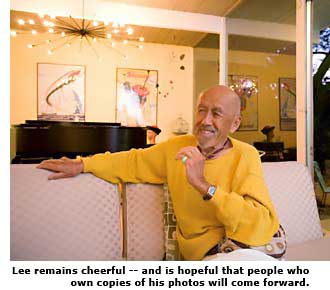Soul Searching: Photographer, Leland Lee - Page 3
"It's an interesting but difficult house to photograph because there's a tremendous amount of glass," Frank Wyle says. "To get the light so you don't see it reflected in the glass is quite a trick. And Leland always wanted to get the inside light balanced with the outside light. He'd often wait until just before sundown."
Wyle, who's worked with many photographers during his career, says Lee stood out for his care and attention to detail.
"Setting up his photographs, he would take sometimes a day to get it just right," Wyle recalls about the shoot for his home, which overlooks a country road and a lake. "He would arrange to have someone on horseback come down the road at just the right time. That's the kind of attention to detail you don't often get."
Lee went on to do corporate photography for Wyle, who owned Wyle Laboratories, an aerospace engineering and testing firm.
Another of Lee's favorite projects is the house John Lautner designed for the interior designer Arthur Elrod in Palm Springs. The now-iconic Elrod house, built into the rocks, remains a modern landmark. Lee first photographed the site before the home was built, so he had some idea what Lautner and Elrod were up to.
Still, Lee recalls, when he showed up for the shoot with architectural editor Will Mehlhorn, from House & Garden, "My God, I couldn't believe my eyes! It was gigantic. I thought Arthur was building a bachelor pad. I was flabbergasted."
"I had to send back immediately for more flashbulbs, and you name it—I had to have some more."
Right away Lee saw one problem that couldn't be solved with extra flash bulbs. "The magnificent side is the cliff side," but there was no way to get there. "I told Arthur, 'I wished I'd had wings!' He hired a cherry picker! He spared no expense."
Lee, who often complains how little time he has for an assignment, spent "all day Thursday, Thursday evening, all day Friday and Friday evening, and Saturday until 6:30," getting it just right. Plus, he returned for shoots several times over the years, as Elrod redid interiors and later brought Lautner in for an expansion.
"That was the most outstanding house by a modern architect I've ever done," Lee says.

In Los Angeles, Lee was part of a lively scene of architects, designers, and design writers, recalls Carol Soucek-King. "When we first met I was just taken by how his clients, the architects and interior designers, just admired him," she says.
"Leland's photographs always seemed so true. He used extra lighting because he said you can't always get what you are trying to show with natural light. But his photos always seemed natural."
"You knew, if someone were bringing you a project photographed by Leland Lee, it would be worth looking at, the project as well as the photography," King says. "He knew such an excellent group of good architects and interior designers. He would never waste your time. He was really good at helping his designers and architects get published because when he called and said he had something, you would say, 'Of course.'"
Lawrence Laughlin, the retired interior designer who helped run the firm Bedell-Laughlin, emphasizes the point. "When you wanted to get your work published in one of the good magazines, you chose photographers they liked and wanted to publish. We always chose people like Leland, and George Szanik, good photographers."
Lee, who was born in San Francisco's Chinatown, lost his father when he was nine, then spent seven years at the Voorhis School for Boys, a top-rank boarding school for disadvantaged youths in San Dimas, near Los Angeles, where he was introduced to photography. "I had an aesthetic bent," he says.
Although Lee is deeply rooted in Chinese culture, his school experience, plus service in the Air Force during World War II that took him to Morocco, India, and China, gave him a multi-cultural perspective. "I've never been tied to any ethnic or social group of any kind," Lee says.
On the whole, he's enjoyed his career, from which he retired when he was 85. He would have kept going, he says, but new, young editors preferred to work with new, young photographers.
Lee's quest to recreate his photography archive has involved calling magazines, his former editors, and designers. "A lot of people for whom I worked are no longer alive," he says, "and a lot of firms went out of business. A lot of people I did a lot of work with, the interior designers, several of them have nothing left. They disposed of their photographs."
But Lee, characteristically, remains hopeful that people who own copies of his photos will respond.
Despite flood and fire, Lee remains a cheerful man. At 91, he amazes King with his continued vitality. He still drives a car and remains a lively conversationalist at her monthly salons on creativity. And Lee has few regrets.
"Each day brought a new surprise," he says of his life. "It was an adventure every time."
This story originally ran in our CA-Modern magazine in 2010. Leland Lee passed away in 2016 at the age of 97. What survives or continues to turn up of his work is being archived at the Art Center College of Design in Pasadena.
Photos: Leland Lee, John Eng (images of Leland Lee); and courtesy Judy McKee (Lee-Shulman photo)
- « first
- ‹ previous
- 1
- 2
- 3




